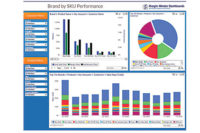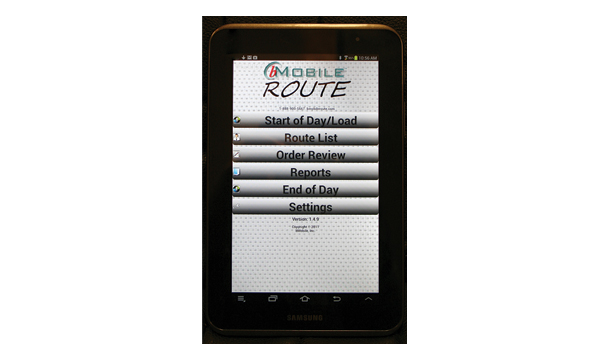Working with DSD gadgets
DSD software, hardware add efficiency to the supply chain

According to bMobile’s Chris Macaw, many companies are opting to use consumer-based Android devices to connect with DSD software while in the field. (Image courtesy of bMobile)

En route to stores, sales and delivery team members can receive specific instructions, directions and contact information on their mobile devices using Xora’s new StreetSmart mobile app. (Image courtesy of Xora Inc.)

Zebra Technologies’ new iMZ220 and iMZ320 mobile printers can print proofs of delivery, invoices and other documents from Apple, Android, Windows and Blackberry devices. (Image courtesy of Zebra Technologies)

Salient’s Collaborative Intelligence Suite gives users the full scope of analytics, including structured and unstructured data, and allows them to monitor and analyze product performance based on geographic and consumer demographic information. (Image courtesy of Salient Management Co.)




Just like the Secret Intelligence Service wouldn’t send James Bond on a mission without the best gadgets, distribution managers need to ensure that their sales and distribution representatives in the field are equipped with all of the tools to get the job done. The age of technology and automation has allowed beverage companies to connect direct-store-distribution (DSD) representatives in the field with important information, data, and analysts and management in the office for improved operating efficiency by using DSD technology.
Many companies that have automated practices by using DSD technology have found that the software and hardware provide great benefits, such as speeding up processes and boosting accuracy and productivity, says Brian Schulte, industry marketing director at Intermec Technologies Corp., Everett, Wash.
These efficiency improvements are especially important in this economy where cost-conscious consumers expect lower prices even though distribution costs are rising, says Patty Harper, vice president of marketing at Xora Inc., Mountain View, Calif. “As a result, beverage companies are constantly seeking cost takeout opportunities and greater operational efficiencies in their distribution systems,” she says. “And because distribution is inherently mobile, many of them are looking to mobile technology to increase the productivity of their employees and/or vehicles in the fleet. Just one extra customer visit per shift or a few hundred or thousand gallons of fuel saved per month can dramatically increase sales while keeping costs in check or even lowering them.”
DSD technology allows all players on a company’s DSD team to access real-time visibility into inventory, relay data, and optimize the ordering and delivery process, says Marty Johnson, product marketing manager for Zebra Technologies, Lincolnshire, Ill.
For the DSD team members in the field, connectivity to distribution data, their managers in the office, or customers on the route can be as easy as using their cell phones, says Chris Macaw, president of bMobile, Eagle, Idaho.
“The newest and most popular change to the DSD community and to bMobile is the use of inexpensive, consumer-based Android devices instead of the Windows mobile devices of old,” bMobile’s Macaw says. “Most drivers have familiarity with consumer phones, and therefore the transition to an Android device for work is an easy transition.”
In addition to familiarity and ease-of-use benefits, many companies are finding that it is more cost-effective to use employees’ personal phones instead of company-purchased devices to connect with DSD software, notes Xora Inc. in its Mobile Workforce Management Buyer’s Guide.
“Employees themselves are driving much of the movement toward mobile applications in businesses,” Xora’s Harper says. “Many of them own their own smartphones and tablets and use them in their daily lives, so they already know how easy and helpful they are.”
However, being out in the field can be a dangerous environment for fragile digital devices, bMobile’s Macaw notes. “[Delivery drivers] are going to be moving around, bumping into things, so their device cannot be fragile,” he says. To accommodate this, bMobile offers an array of rugged handheld mobile computers under the Psion, Ikon, Janam and Motorola brands featuring long battery life, built-in scanners and cameras, wireless networking, and voice and data communications, according to the company’s website.
From start to finish
Different DSD hardware and software applications can optimize sales, distribution and delivery personnel’s daily tasks.
For starters, Intermec’s Vocollect software uses voice technology to facilitate easier truck loading through heads-up, eyes-free and hands-free functionality for enhanced accuracy and efficiency, Intermec’s Schulte says. Instead of reading a printed report, the user can listen to voice directions from the software that instruct him or her to pick specific items, load the items onto the truck, and request more directions through vocal responses.
For improved functionality, users can speed up the voice commands to go through the picking and loading processes more quickly or change the language if they are more fluent in another language, he adds.
En route to stores, sales and delivery team members can receive specific instructions, directions and contact information on their mobile devices using Xora’s new StreetSmart mobile app. This Android-, Apple- and Blackberry-compatible application also can be used to leverage a global positioning system (GPS) to alert merchandisers when the driver is about to approach the loading dock or after a delivery has been made, Xora’s Harper says.
For the sales representative walking into a store to meet a new client or negotiate a sale with an existing client, Salient Management Co. offers a Storyboarding feature in its Collaborative Intelligence Suite that allows the representative to share analyst-compiled reports and information to deliver a story about a new product or brand to a prospective buyer.
“It is pre-built and walk-through, so [report authors] can go from one store to the next store, from one chain to the next chain, and tell exactly how they want that [story] built [for each store presentation],” says Paul Osinski, senior vice president of commercial sales for the Horseheads, N.Y.-based company. This allows a sales representative to pull up a specialized presentation with sales data and information for each individual store client, he says. “And we find that people feel that that’s very powerful,” he adds. “Again, it’s helping them do their business better, faster, more efficiently and more profitably.”
To handle beer and beverage pricing structures when making a sale, DSD team members can make use of bMobile Route. This software also gives the route person more presale options and instant recall of future promotions and on-hand warehouse inventory, the company says.
When finalizing a sale or delivery, a DSD team member can use mobile printers to print an invoice or receipt for their customers right on the spot. Zebra Technologies’ new iMZ220 and iMZ320 mobile printers can print proofs of delivery, invoices and other documents from Apple, Android, Windows and Blackberry devices, Zebra’s Johnson says. For more rugged applications, Zebra also offers its Road Warrior (RW) series of mobile printers, which also features a liquid crystal display (LCD) screen to show battery life and network status as well as a vehicle cradle for on-the-road operation, the company says.
To further facilitate the transaction process in the store, Intermec offers Remote Deposit Capture (RDC) and Mobile Document Imaging applications on its devices. RDC allows a DSD team member to capture a check electronically and start the payment cycle immediately. When the user scans the front and back of the check, the application automatically captures and interprets pertinent information like the bank number, account number and check number and transmits it electronically so that the user does not have to worry about a lost or damaged check, Intermec’s Schulte says. Mobile Document Imaging enables a user to capture up to 8.5- by 11-inch documents, such as signed invoices, and transmit them to the company office. As this is a mobile document imaging system instead of a document photography application, users do not have to look through a viewfinder or at a screen to capture the image but instead hold the scanner above the document and allow it to scan the document like a barcode scanner, the company says.
In addition, the Mobile Document Imaging application is able to automatically adjust the document image if the scan is up to 35 degrees off-center or up to 10 degrees rotated, the company says.
At the end of the day when the DSD team members have completed their routes, they can use the Xora StreetSmart mobile app to record their work hours for the day and transmit sales orders for processing. This saves the DSD team members an extra trip to the company office to drop off time sheets or orders and can directly connect their information to company payroll or sales offices for faster processing, Xora’s Harper says.
Behind the desk
DSD software is not just for team members out in the field. Salient’s Osinski says everyone in a company that has an effect on spending and money can use the software. “If you can effect a change in money, you need to be able to see that specific transaction and how it affects your business,” he says. “It’s not just an executive tool; it’s not just an analytical tool; it’s [for] everyone that affects both sales [and] production or touches money within an organization.”
In the office, the use of DSD software helps companies gain a better understanding of where their money is spent and what their return on investment is, Salient’s Osinski says.
Salient’s Collaborative Intelligence Suite gives users the full scope of analytics, including structured and unstructured data, notes, videos, and static and live planograms, Osinski says. Within this software suite, analysts can use the Salient Dashboard Mining capabilities to monitor and analyze product performance based on geographic and consumer demographic information, he says.
“To be able to compete in today’s world, we find that our clients really need to get down to not just pushing cases and dollars through the system but pushing the right cases to that exact consumer in that exact field to ensure that they’ve gotten the right mix in a store and don’t lose distribution in retail stores [or] within a retail chain,” Osinski says. The software suite also can pull in data from retailers to allow analysts to optimize the sales and inventory processes by figuring out the optimal delivery frequency to prevent both out-of-stocks and over-inventory, he adds.
Similarly, bMobile Route software allows users to view and analyze sales forecasts by customer, season, holiday and promotion. In addition, the company is working on an added feature that can forecast sell-through based on weather fluctuations, bMobile’s Macaw says.
Managers in the office also can use DSD technology to track their employees in the field. Xora’s StreetSmart Web-based application uses GPS and Google Maps technology to show where drivers are and where they have been throughout the day. It also can capture the amount of time spent driving compared with time spent at a customer location. Based on this data, managers can better understand costs and analyze the system to optimize the delivery route, Xora’s Harper says.
Intermec’s Skynax software also allows managers to monitor and communicate with their DSD employees in the field. With Skynax, a manager can view all of the company’s routes, make sure route drivers are communicating with the company, and send and receive software, files and other information to and from employees on their routes. “For example, if you have new products that got introduced or pricing changes [that] happened, all of those routes [can] have the most current information,” says Intermec’s Schulte.
DSD technology connects members of the distribution supply chain — from managers at their desks to sales representatives and delivery drivers in the field — with the most up-to-date data and information to facilitate sales and deliveries and optimize their distribution systems. “People need information, because everybody else is armed with information, in order to protect [their] turf,” Salient’s Osinski says. In the future, Osinski believes using DSD software at every level of every organization will be even more critical going forward to understand transportation, sales, logistics and all other components of the DSD system.
Looking for a reprint of this article?
From high-res PDFs to custom plaques, order your copy today!










